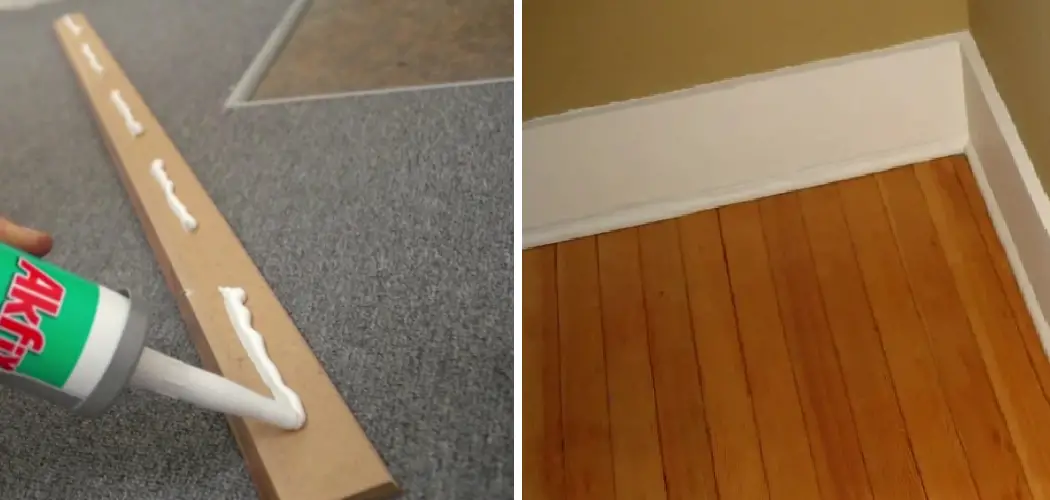Are you wondering how to install baseboards without nail gun? While it may seem difficult to do at first, this task doesn’t have to be overwhelming. With the right tools and materials, you can easily install your baseboard trim with no fuss.
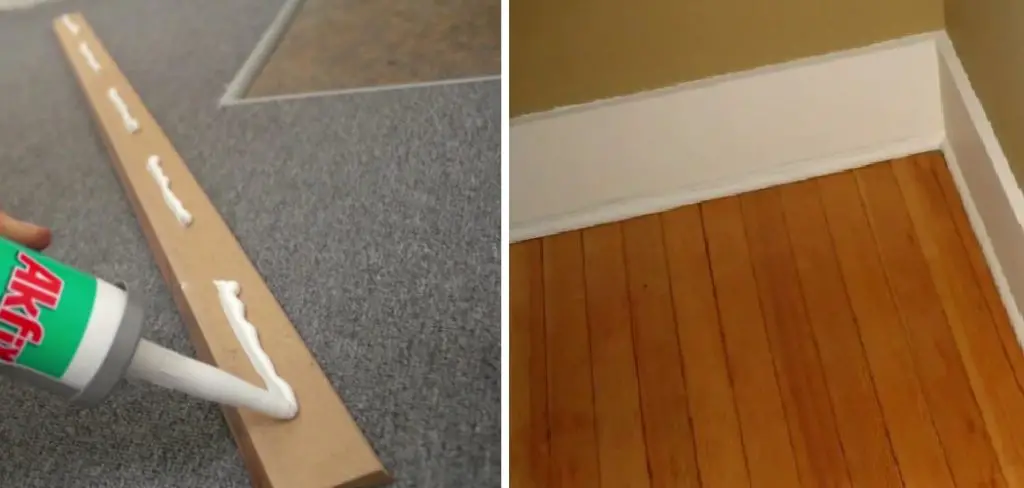
Baseboard trim is an important finishing touch to any room, as it covers the gap between your wall and floor. It not only adds aesthetic value but also helps protect your walls from scuff marks and damage.
In this article, we’ll walk through how to measure, cut, and attach the boards securely – all without relying on a nail gun! You’ll find plenty of tips for simplifying what could have been a daunting job. Plus, in no time at all, you’ll have beautiful new baseboards throughout your home. So, let’s get started – read on to learn more!
What Will You Need?
Before diving into the steps for installing baseboards without a nail gun, let’s ensure you have all the necessary tools and materials. You will need:
- A tape measure
- A miter saw, or hand saw
- A coping saw (optional)
- Adhesive caulk (optional)
- Baseboard trim boards of your choice
- Finishing nails (optional)
- A hammer or nail punch
- A putty knife
- Sandpaper
- Paint and paintbrush (optional)
Once you have all of these items, you can begin the installation process.
10 Easy Steps on How to Install Baseboards Without Nail Gun
Step 1: Measure Your Space
To begin, measure the perimeter of your room where you will be installing the baseboards. This will help you determine how much material to purchase. It’s always a good idea to buy a little extra in case of mistakes or miscalculations.
Step 2: Cut the Baseboard Trim
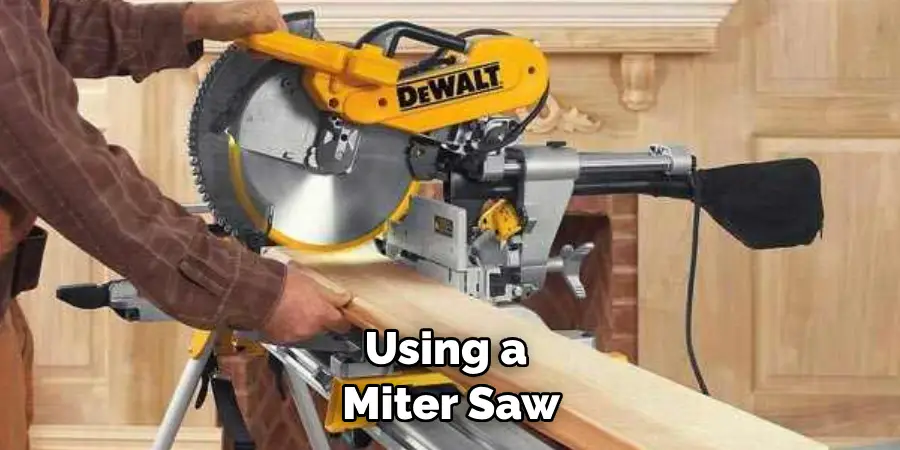
Now that you have your measurements, it’s time to cut your baseboard trim. If you’re using a miter saw, set it to a 45-degree angle for the corners. Alternatively, carefully cut the board at a 45-degree angle if you’re using a hand saw. Remember to take your time with this step to ensure a precise cut. This will make it easier to neatly fit the boards at the corners.
Step 3: Dry Fit the Baseboards
Before securing the baseboards to the wall, it’s recommended to do a ‘dry fit’. This involves holding up or temporarily tacking the cut pieces in place to ensure they fit correctly. Pay special attention to the corners to make sure the 45-degree cuts join nicely. You may need to adjust your cuts or sand the edges for a precise fit. This step will help prevent any unsightly gaps or overlaps in your finished project.
Step 4: Apply Adhesive Caulk (Optional)
If you prefer not to use finishing nails, consider using adhesive caulk instead. Apply a thin bead of adhesive along the back of the baseboard, making sure to avoid the edges. This will help secure the baseboard to the wall without needing nails.
It might take some time for the adhesive to fully dry, so you’ll need to prop the baseboard in place until it’s completely set. Be careful not to stain the wall with excess adhesive. A putty knife can carefully remove any extra adhesive that seeps out when the baseboard is pressed against the wall.
Step 5: Attach the Baseboard
Once the adhesive is fully dry, your baseboard should be firmly attached to the wall. However, if you prefer a more secure attachment or if you are not using adhesive, you can use finishing nails.
Position the baseboard along the wall, ensuring it is level and fits correctly. Once it’s in the right position, hammer the finishing nails into the board and wall. For a cleaner finish, use a nail punch to drive the nails slightly below the surface of the baseboard. Be careful not to hammer too hard as this could damage the baseboard.
Step 6: Fill Nail Holes and Sand
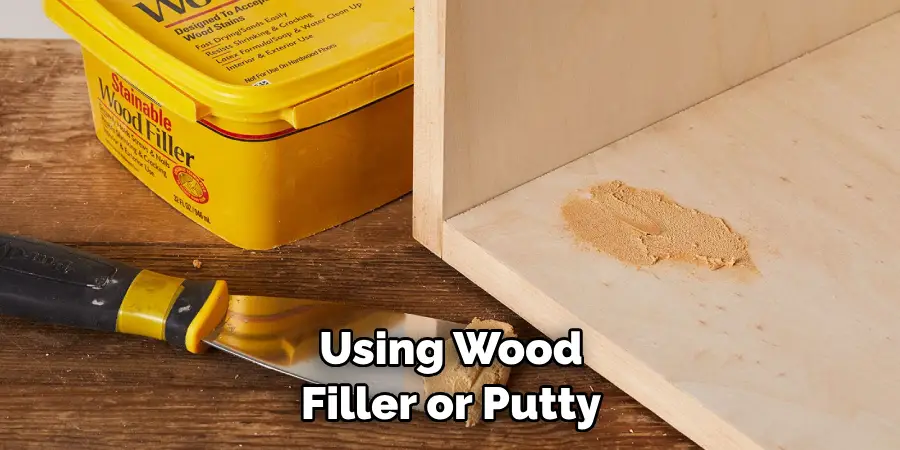
After securing the baseboard, you may notice nail holes. Fill these in using wood filler or putty. Using your putty knife, apply a small amount to each hole, ensuring it’s flush with the surface of the baseboard. Once the filler has dried, use sandpaper to smooth the surface. This helps to create a seamless appearance, preparing the baseboard for the final touches.
Step 7: Paint or Stain (Optional)
If you want your baseboards to match the existing décor or to add a pop of color, consider painting or staining them. Ensure the baseboard is clean and free of dust before applying either paint or stain. Start by applying a primer, let it dry, and then apply your chosen color or stain. Remember to use small strokes in the direction of the grain for a smooth finish. Allow the paint or stain to dry completely before moving on to the next step.
Step 8: Install the Corner Pieces
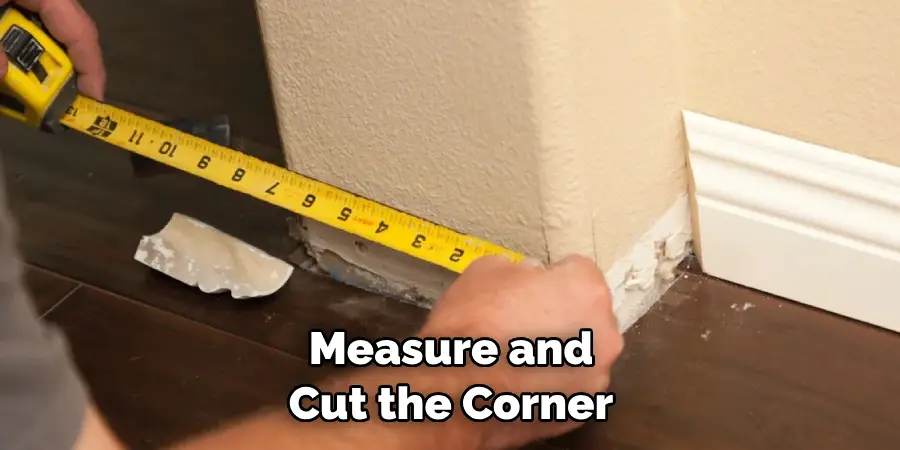
Once the baseboards are painted or stained, installing the corner pieces is time. These are optional, but add a finished look to your baseboards. Measure and cut the corner pieces to fit your room’s corners. Like the baseboards, use adhesive caulk or finishing nails to secure them to the wall. Make sure they align nicely with the baseboards for a seamless look. Fill in any nail holes with wood filler, sand smooth, and touch up with paint or stain as needed.
Step 9: Seal the Baseboards
Once your corner pieces are in place and all paint or stain is dry, it’s time to seal the baseboards. This is an optional step, but it can add extra protection to your baseboards and make them easier to clean. Use a clear sealant and apply a thin layer over the baseboards and corner pieces. Make sure to let it dry fully before proceeding to the final step.
Step 10: Clean Up
Congratulations, you’ve installed your baseboards without using a nail gun! Now, it’s time to clean up. Remove any remaining adhesive, wood filler, or paint from your tools and work area. Sweeping or vacuuming will also remove any dust or debris from the installation process. Stand back and admire your hard work – your room now has a polished, finished look thanks to your new baseboards.
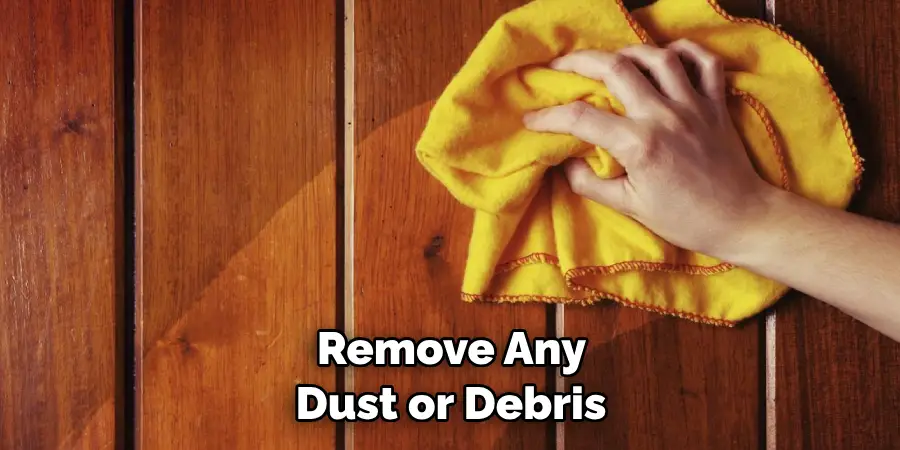
By following these ten easy steps, you can install baseboards without needing a nail gun. With just a few basic tools and some patience, you can achieve a professional-looking finish and add value to your home.
5 Additional Tips and Tricks
- Use Quality Material: Opt for high-quality baseboards for a more durable finish and fewer issues during installation. Although they might be more expensive, the long-term benefits outweigh the initial cost.
- Precision Cutting: Ensure precision in your measurements before cutting the baseboards. Remember, it’s always better to cut a bit longer and trim down as needed than to cut too short.
- Adhesive Choice: Since you won’t be using a nail gun, a strong adhesive is crucial. Construction adhesive is a great choice for attaching baseboards to walls without nails.
- Securing the Baseboards: To help the adhesive bond, apply pressure to the baseboard after mounting it on the wall. You can use weighted objects or clamps to hold the baseboards in place until the adhesive is fully cured.
- Finishing Touches: After the adhesive has dried, use a high-quality, paintable caulk to seal the top edges of the baseboard where it meets the wall. This will give a finished, professional look and help prevent dust from collecting behind the baseboard.
These additional tips and tricks allow for installing baseboards without a nail gun. Always measure carefully, use quality materials and adhesive, and add the finishing touches for a flawless result.
5 Things You Should Avoid
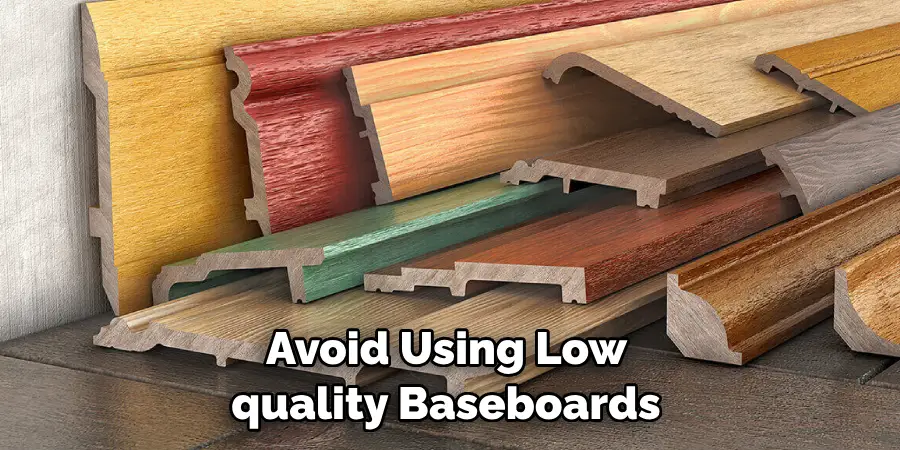
- Avoid Rushing: Even though you might be eager to finish, don’t rush the process. Take the time to measure and cut accurately, apply adhesive properly, and allow it to dry fully before moving on to the next step.
- Refrain from Skimp on Materials: Cheap materials can lead to inferior results. Avoid using low-quality baseboards or adhesives. They may not adhere as well, leading to loose baseboards over time.
- Avoid Gaps: Always ensure that the baseboards fit snugly against the wall and each other. Gaps not only mar the appearance but also undermine the adhesive bond.
- Don’t Neglect Safety: Installing baseboards can involve sharp tools and potentially harmful materials. Make sure to pay attention to safety gear such as gloves and goggles, and ensure your workspace is well-ventilated when using adhesives.
- Avoid Not Preparing the Surface: For the adhesive to work effectively, the wall where you’re installing the baseboard should be clean and dry. Pay attention to this preparation step.
Avoiding these common pitfalls will help ensure a successful and professional-looking baseboard installation process, even without a nail gun.
Is It Better to Nail or Glue Baseboards?
This is a common question for those considering installing baseboards without a nail gun. While both methods can be effective, using glue eliminates the need for nails, which can save time and effort. Additionally, adhesive will often create a stronger bond than nails, which can loosen over time due to natural movement in the walls. However, if you prefer using nails or have trouble with adhesive, nailing baseboards is still viable.
Ultimately, the decision on whether to use nails or glue for your baseboard installation will depend on personal preference and the specific project. Just remember to follow these tips and avoid common mistakes for a successful and hassle-free installation process.
What is the Best Glue for Baseboards?
When choosing the best adhesive for your baseboards, there are a few options. Construction adhesive is popular due to its strength and ability to bond multiple materials together. Other good options include instant grab adhesives, polyurethane adhesives, or liquid nails.
Whichever type of glue you choose, make sure it is designed for construction purposes and is strong enough to hold the weight of the baseboards. It’s also a good idea to test a small area before applying it to the entire length of the baseboard.
Knowing how to install baseboards without a nail gun can be useful for DIY projects or areas where using a nail gun may not be feasible. By following these tips and tricks, you can achieve a professional-looking baseboard installation without using nails. Remember to take your time, use quality materials, and prioritize safety for the best results. So go ahead and give it a try – you might surprise yourself with how easy it can be!
Why Baseboards Need Nails Instead of Screws?
Baseboards are typically attached to walls using nails rather than screws for a few reasons. First, baseboards are usually made of thinner and softer materials than other types of trim, making them more susceptible to splitting or cracking when using screws. Nails offer a better hold without damaging the material.
Additionally, baseboards often need to be installed quickly and efficiently, and nails can be hammered in faster than screws can be drilled. This makes them a preferred choice for contractors and DIY enthusiasts alike.
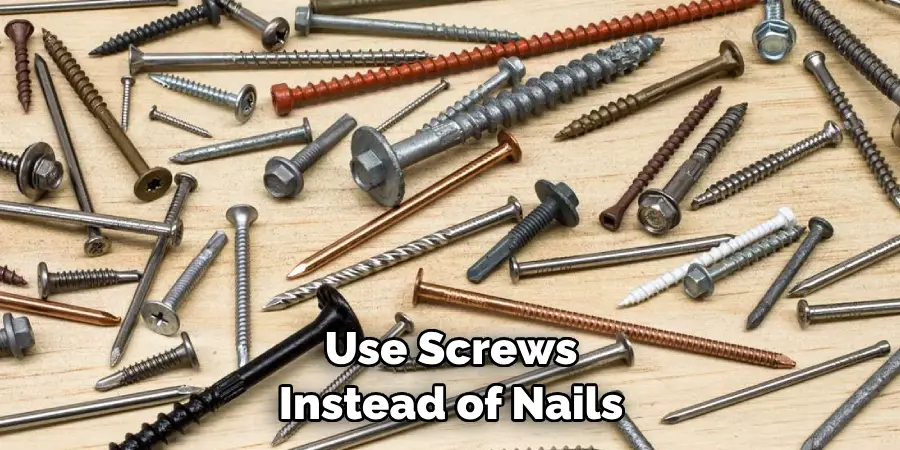
While it is possible to use screws instead of nails, it may require pre-drilling holes and special techniques to avoid damaging the material or causing it to split. For most baseboard installations, using nails will provide the best results and save time.
Conclusion
In conclusion, installing baseboards without a nail gun is a simple and effective way to spruce up your home. The key is to ensure that the baseboards are cut cleanly and accurately before adhering them to the wall. Now that you have learned how to easily install baseboards, it’s time to start your interior design project! Gather the materials, measure twice, and begin nailing or gluing your pieces into place.
Hopefully, the article on how to install baseboards without nail gun has given you the confidence and knowledge to tackle this project on your own. You’ll have a beautiful result with patience and precision in no time. And remember: designing your home can be fun for everyone, so be sure to share this DIY experience with family and friends.
So ensure you’re equipped with the right tools – whether a hammer or a nail gun – and get crafty with your interior design goals today!

